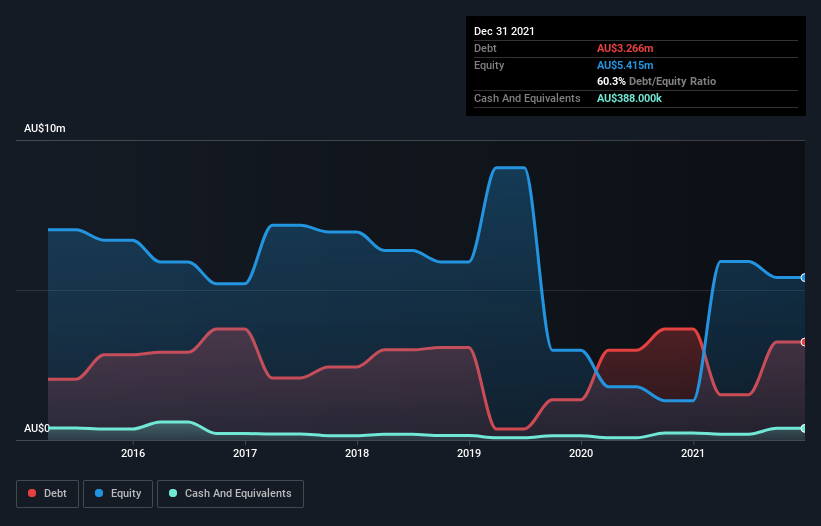Howard Marks put it nicely when he said that, rather than worrying about share price volatility, 'The possibility of permanent loss is the risk I worry about... and every practical investor I know worries about.' So it might be obvious that you need to consider debt, when you think about how risky any given stock is, because too much debt can sink a company. We note that AstiVita Limited (ASX:AIR) does have debt on its balance sheet. But is this debt a concern to shareholders?
What Risk Does Debt Bring?
Debt and other liabilities become risky for a business when it cannot easily fulfill those obligations, either with free cash flow or by raising capital at an attractive price. Ultimately, if the company can't fulfill its legal obligations to repay debt, shareholders could walk away with nothing. However, a more usual (but still expensive) situation is where a company must dilute shareholders at a cheap share price simply to get debt under control. By replacing dilution, though, debt can be an extremely good tool for businesses that need capital to invest in growth at high rates of return. The first step when considering a company's debt levels is to consider its cash and debt together.
View our latest analysis for AstiVita
What Is AstiVita's Net Debt?
As you can see below, AstiVita had AU$3.27m of debt at December 2021, down from AU$3.70m a year prior. However, it also had AU$388.0k in cash, and so its net debt is AU$2.88m.

A Look At AstiVita's Liabilities
The latest balance sheet data shows that AstiVita had liabilities of AU$780.0k due within a year, and liabilities of AU$3.31m falling due after that. On the other hand, it had cash of AU$388.0k and AU$723.0k worth of receivables due within a year. So its liabilities outweigh the sum of its cash and (near-term) receivables by AU$2.98m.
AstiVita has a market capitalization of AU$14.2m, so it could very likely raise cash to ameliorate its balance sheet, if the need arose. But we definitely want to keep our eyes open to indications that its debt is bringing too much risk. When analysing debt levels, the balance sheet is the obvious place to start. But you can't view debt in total isolation; since AstiVita will need earnings to service that debt. So when considering debt, it's definitely worth looking at the earnings trend. Click here for an interactive snapshot.
In the last year AstiVita had a loss before interest and tax, and actually shrunk its revenue by 7.4%, to AU$3.9m. We would much prefer see growth.
Caveat Emptor
Importantly, AstiVita had an earnings before interest and tax (EBIT) loss over the last year. To be specific the EBIT loss came in at AU$752k. Considering that alongside the liabilities mentioned above does not give us much confidence that company should be using so much debt. So we think its balance sheet is a little strained, though not beyond repair. Another cause for caution is that is bled AU$5.1m in negative free cash flow over the last twelve months. So suffice it to say we consider the stock very risky. The balance sheet is clearly the area to focus on when you are analysing debt. But ultimately, every company can contain risks that exist outside of the balance sheet. For example AstiVita has 6 warning signs (and 3 which shouldn't be ignored) we think you should know about.
If you're interested in investing in businesses that can grow profits without the burden of debt, then check out this free list of growing businesses that have net cash on the balance sheet.
New: Manage All Your Stock Portfolios in One Place
We've created the ultimate portfolio companion for stock investors, and it's free.
• Connect an unlimited number of Portfolios and see your total in one currency
• Be alerted to new Warning Signs or Risks via email or mobile
• Track the Fair Value of your stocks
Have feedback on this article? Concerned about the content? Get in touch with us directly. Alternatively, email editorial-team (at) simplywallst.com.
This article by Simply Wall St is general in nature. We provide commentary based on historical data and analyst forecasts only using an unbiased methodology and our articles are not intended to be financial advice. It does not constitute a recommendation to buy or sell any stock, and does not take account of your objectives, or your financial situation. We aim to bring you long-term focused analysis driven by fundamental data. Note that our analysis may not factor in the latest price-sensitive company announcements or qualitative material. Simply Wall St has no position in any stocks mentioned.
About ASX:AIR
AstiVita
AstiVita Limited imports and distributes household and renewable energy products in Australia.
Mediocre balance sheet with weak fundamentals.
Market Insights
Community Narratives



